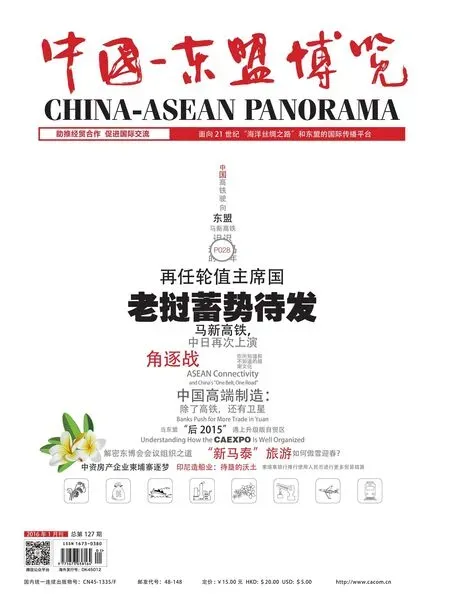柬埔寨银行推行使用人民币进行更多贸易结算
□文/Sor Chandara
柬埔寨银行推行使用人民币进行更多贸易结算
□文/Sor Chandara
随着中国与柬埔寨之间贸易规模的不断扩大,柬埔寨银行从业人员已请求增设相关银行设备,以便于使用中国货币(人民币)进行进出口贸易的结算。
在一场由中国银行主办的研讨会上,中国银行金边分行首席执行官陈长江指出,自柬埔寨国家银行(NBC)授权该分行为办理柬埔寨当地及中柬两国跨境人民币交易业务的结算银行以来,人民币在中柬两国贸易往来过程中的交易数额稳步上升。
陈长江说:“人民币国际化不仅可以推动中国与世界之间的不断融合,而且能够为跨境投资、跨境贸易以及跨境金融交易提供更多渠道。”
他补充道,截至2015年前6个月,中国银行驻金边分行已办理的跨境汇付业务总额为3500万元人民币,折合550万美元。
在柬埔寨国内,准许办理人民币结算业务的银行一共有两家:一家是中国银行,另一家是中国工商银行。
很多柬埔寨当地的金融机构也为商家或企业提供人民币结算服务。
据中国银行相关报道显示,2014年,中国与柬埔寨双边贸易额突破37亿美元,预计将于2017年突破50亿美元。
中国银行香港分行经济与战略规划部主管E Zhihuan表示,中国与柬埔寨之间贸易往来的快速发展,为两国以人民币为基础进行交易的进一步发展奠定了坚实的基础,也为柬埔寨打造了一个规模可观的“人民币”流动库。
E Zhihuan 说:“使用人民币进行结算将使柬埔寨企业从中受益,尤其是对面向中国出口的柬埔寨企业来说,将享受到具有稳定性好的货币支付业务。”
“从另一方面来讲,就中国的进口而言,使用人民币进行贸易支付有望提升商家的议价能力,帮助他们通过协商获得优价商品。”
独立经济学家Srey Chanthy称,对柬埔寨国家的经济来说,使用人民币与中国进行贸易结算没有任何问题,这将有利于更好地协调两国之间的商贸活动。然而,将人民币用于日常交易有可能不利于柬埔寨现有的银行业务系统。
“如果我们像使用美元那样使用人民币,将会出现一些问题。对柬埔寨人民来说,这样做会让他们感到费解,可能导致其对柬埔寨银行业务系统丧失信心,进而不再将他们的钱存入银行。”他说。
他接着指出,在贸易结算方面,使用人民币进行结算有可能会保护贸易商免遭美元汇率波动所带来的潜在损失。
柬埔寨小额信贷联合会主席Bun Mony表示,柬埔寨目前仍主要使用美元和欧元进行贸易结算,人民币在贸易结算中仅占少量比重。
“倘若中国有意推行人民币在国际贸易结算中的使用,需要加大人民币在市场中的投放力度。”他说,“如果人民币的投放量加大且在国际贸易中的使用量增加,我相信,柬埔寨在贸易结算过程中使用的人民币的数量会随之增加。”从人民币国际化不仅可以推动中国与世界之间的不断融合,而且能够为跨境投资、跨境贸易以及跨境金融交易提供更多渠道。
许志亮译
来源:柬埔寨《金边邮报》官网
Importing from China Can Complement Indian Manufacturing
written by Ishu Jain

C hina is rightly called the "factory of the world." Chinese products seem to be everywhere:Every day we see tags,labels and stickers displaying the legend "Made in China." In recent times,pundits have wondered if China will lose its spot as other economies offering cheap labor dull China's competitive edge.However,the availability of cheap labor is just one of the many factors that have made China a manufacturing hub,and it will take more than cutthroat desire for emerging economies to set up a business ecosystem that can compete with China's.
In September 2014,Indian Prime Minister Narendra Modi outlined the "Make in India" program,which aims at promoting India as an investment destination and a global hub for manufacturing,design and innovation.
After the launch of the "Make in India" initiative,recently there have been a lot of talks about manufacturing moving from China to India.The Western media likens it to a zero-sum game between the two Asian giants,and pose hypothetical question on whether "Make in India" can overtake "Made in China."
Demographics is the key,both to India's success and China's stagnation,in the coming years.The size of China's labor force decreased for the third year in a row in 2015,whereas India has demographics in its favor with the working age population set to rise by 125 million in the next decade.This vast human resource pool in India will keep wages competitive and provide scale of operations to the manufacturers.The employees,in turn,will add to the expanding affl uent middle-class in India and thus providing a huge internal market.
India's government hopes that hundreds of Chinese companies will become part of India's industry.China has actively entered Indian markets in recent years.Lenovo Group announced that it began making smart phones in the Indian city of Chennai while Foxconn,the maker of iPhones,plans to open plants in all the major Indian states.
China has over 30 years of experience in producing goods for Western markets.In this time,Chinese companies have acquired a knowledge base to get to the point where it's not only cheap goods being made,but also high quality.While China moves into a middle-income country bracket,there would be movement of labor intensive low-cost goods manufacturing to other countries; but mediumto-high end manufacturing will still remain China's sweet spot.
Industrial production does not take place in isolation,but rather relies on networks.The business ecosystem in China has evolved quite a lot in the last 30 years.For example,Shenzhen has evolved as a hub for the electronics industry.It has cultivated an ecosystem to support the supply chain.There are so many established production ecosystems like this in China that it is very difficult to transfer production anywhere else.
Coinciding with the "Make in India" pitch,the Chinese government has launched a "Made in China 2025" campaign with a host of tax concessions in an effort to retain its manufacturing prowess.China will encourage high-tech imports,research and development (R&D) to upgrade "Made in China",according to the decision announced by the Chinese central government.Under the new campaign China will use tax breaks to encourage enterprises to upgrade their equipment and increase R&D efforts to improve the manufacturing industry.
China's new move aims to prompt the technical improvement of companies.The State Council asked government organs to implement the new measures as soon as possible to arm "Made in China" with advanced technology and equipment,encouraging more competitive products with high added value.
Thus China and India will together emerge as the manufacturing beacons of 21st century - with China focusing on the hightech,high-value added manufacturing while Indian government's primary focus will be on high-volume and labor-intensive manufacturing.
We should try to combine "Make in India" and "Made in China" together.The key word in India-China relationship is development,which is a major factor of our cooperation.What gets less attention but matters more is that Indian imports from China are mostly capital goods that are industrializing India and retail merchandise is a small part of bilateral trade.Rather than stifl e Indian manufacturing,importing from China is actually complementary to growing Indian exports.
Resource:www.globaltimes.cn
The author is head of China & South East Asia at Invest India,a joint venture between Federation of Indian Chambers of Commerce and Industry and Government of India.
- 中国-东盟博览(政经版)的其它文章
- 汽车
- nformation
- 农业
- 旅游
- 马新高铁迟迟未上马的17年
- 金融

